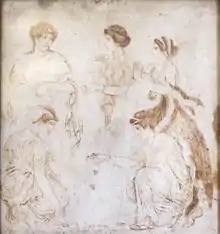Phoebe (Titaness)
In ancient Greek religion, Phoebe (Greek: Φοίβη Phoibe, associated with Phoebos or "shining") was one of the first generation of Titans, who were one set of sons and daughters of Uranus and Gaia.[1] She was the grandmother of Apollo, the god of the Sun, and Artemis, goddess of the moon, and was, like her granddaughter Artemis, identified by the Romans poets with the Roman moon-goddess Diana.[2]
| Phoebe | |
|---|---|
| Member of the Titans | |
 A fresco of Herculaneum showing women playing knucklebones, depicting Phoebe, Leto, Niobe, Hilearia, and Agle, painted and signed by an artist named "Alexander of Athens", 1st century AD, now in the Museo Archeologico Nazionale (Naples) | |
| Personal information | |
| Parents | Uranus and Gaia |
| Siblings |
|
| Consort | Coeus |
| Offspring | Leto, Asteria |
Mythology
Phoebe is a Titaness whose consort was her brother Coeus, with whom she had two daughters, Leto, who bore Apollo and Artemis, and Asteria, a star-goddess who bore an only daughter, Hecate.[3]
Through Leto, Phoebe was the grandmother of Apollo and Artemis. The names Phoebe and Phoebus (masculine) came to be applied as synonyms for Artemis and Apollo respectively (as well as for Selene and Helios).[4]
According to a speech, that Aeschylus in The Eumenides puts in the mouth of the Delphic priestess herself, Phoebe received control of the Oracle at Delphi from Themis: "Phoebe in this succession seems to be his private invention," D. S. Robertson noted, reasoning that in the three great allotments of oracular powers at Delphi, corresponding to the three generations of the gods, "Ouranos, as was fitting, gave the oracle to his wife Gaia and Kronos appropriately allotted it to his sister Themis."[5] In Zeus' turn to make the gift, Robertson speculates, Aeschylus could not report that the oracle was given directly to Apollo, who had not yet been born, and thus Phoebe was interposed.[6] These supposed male delegations of the powers at Delphi as expressed by Aeschylus are not borne out by the usual modern reconstruction of the sacred site's pre-Olympian history.
Genealogy
Notes
- Hesiod, Theogony 116-138.
- Boyle, p. 147.
- Hesiod, Theogony 404–452.
- Compare the relation of the comparatively obscure archaic figure of Pallas and Pallas Athena.
- Robertson, p. 70.
- Robertson, p. 70.
- Hesiod, Theogony 132–138, 337–411, 453–520, 901–906, 915–920; Caldwell, pp. 8–11, tables 11–14.
- Although usually the daughter of Hyperion and Theia, as in Hesiod, Theogony 371–374, in the Homeric Hymn to Hermes (4), 99–100, Selene is instead made the daughter of Pallas the son of Megamedes.
- According to Hesiod, Theogony 507–511, Clymene, one of the Oceanids, the daughters of Oceanus and Tethys, at Hesiod, Theogony 351, was the mother by Iapetus of Atlas, Menoetius, Prometheus, and Epimetheus, while according to Apollodorus, 1.2.3, another Oceanid, Asia was their mother by Iapetus.
- According to Plato, Critias, 113d–114a, Atlas was the son of Poseidon and the mortal Cleito.
- In Aeschylus, Prometheus Bound 18, 211, 873 (Sommerstein, pp. 444–445 n. 2, 446–447 n. 24, 538–539 n. 113) Prometheus is made to be the son of Themis.
References
- Aeschylus, Persians. Seven against Thebes. Suppliants. Prometheus Bound. Edited and translated by Alan H. Sommerstein. Loeb Classical Library No. 145. Cambridge, Massachusetts: Harvard University Press, 2009. ISBN 978-0-674-99627-4. Online version at Harvard University Press.
- Apollodorus, Apollodorus, The Library, with an English Translation by Sir James George Frazer, F.B.A., F.R.S. in 2 Volumes. Cambridge, Massachusetts, Harvard University Press; London, William Heinemann Ltd. 1921. Online version at the Perseus Digital Library.
- Caldwell, Richard, Hesiod's Theogony, Focus Publishing/R. Pullins Company (June 1, 1987). ISBN 978-0-941051-00-2.
- Hesiod, Theogony, in The Homeric Hymns and Homerica with an English Translation by Hugh G. Evelyn-White, Cambridge, Massachusetts., Harvard University Press; London, William Heinemann Ltd. 1914. Online version at the Perseus Digital Library.
- Homeric Hymn to Hermes (4), in The Homeric Hymns and Homerica with an English Translation by Hugh G. Evelyn-White, Cambridge, Massachusetts., Harvard University Press; London, William Heinemann Ltd. 1914. Online version at the Perseus Digital Library.
- Robertson, D.S., "The Delphian Succession in the Opening of the Eumenides" The Classical Review 55.2 (September 1941, pp. 69–70). JSTOR 703888.
- Boyle, A. J. (editor), Seneca: Medea: Edited with Introduction, Translation, and Commentary, OUP Oxford, 2014. ISBN 9780199602087.
